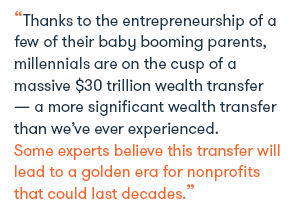MILLENNIALS — ARE THEY REALLY DISRUPTING PHILANTHROPY?
MILLENNIALS — ARE THEY REALLY DISRUPTING PHILANTHROPY?
Andrea McManus, ViTreo Group Inc
October 16th 2018
Over the past decade, my cohort and I — the baby boomers — have gone from being the most talked about generation to being pretty much the ‘older’ generation. With apologies to GenX and GenY, the boomers’ perch at the top of the food chain — or the marketing focus — has been replaced by the millennials. In 2018, young people between the ages of 22-37, are the largest demographic in North America. There’s a great deal of conversation occurring about how millennials have different wants and needs than their parents and grandparents as donors, employees, customers and so on.
Is this true? Yes. And no.
Yes, they are different
From the time they were tweens or teenagers, many of them owned a smartphone. Because information is so accessible, many are far more informed than their parents and grandparents were at this time in their lives. They’re likely also a little more savvy — they’ve had to sift through the tsunami of information disseminated daily, and to dig to find what’s authentic, genuine and worthy of their interest. And they are certainly more global citizens.
Yes, they’re the same
They’re still people, as individual as you or I. And the same as you and I. And human beings since time immemorial crave the same things. Connection and understanding. We want to belong. And most of us want to do some good in the world.
There is a great, and somewhat tongue-in-cheek, article on Mashable that lists 70 things millennials have killed — everything from buffalo wild wings to focus groups to marmalade (70 Things Millennials have Killed).
Some things we know
According to Forbes Magazine, by 2020, millennials will represent more than fifty percent of the workforce — they’ll be earning more, starting to pay off student debt and having some disposable income. And they will also be the beneficiaries in the near future of what’s estimated to be a $30 trillion wealth transfer. Both of these factors will have enormous impact for the nonprofit sector as two things we do know about millennials are:
They have a deep desire to create change in the world, and
They grew up believing in giving back.
In fact there is the potential for millennials to become history’s most generous generation yet. The information we’re seeing is that they are already donating at higher rates. (source: Forbes 2018 millenials are changing philanthropy)
Changing the shape of philanthropy
A group of already influential millennial philanthropists exists. Many others want to be involved, to have an impact. As is pretty much everyone today, they are swamped with competing messages for their attention. With their desire for more work-life balance and for social change, millennials are changing the shape of both the workplace and the philanthropic sector.
Think contribution rather than consumption, qualitative vs quantitative, challenging the status quo and challenging the ‘one size fits all’ mentality.
How can we, as fundraisers and nonprofit leaders, capitalize on this? How do we capture their attention and keep it? How do we engage with them in ways that are meaningful to them? And how do we ensure our organizations pay attention?
There are numerous strategies for adapting the message which have been covered by far more experienced people than I — and I respectfully defer to them in this regard.
But I think we also need to exercise bold leadership and change the way our sector and our profession responds to trends so that we are leading and not catching up.
There is a plethora of research just waiting for us to mine and apply. From behavioural economics (have you read one of the most recent and comprehensive to me, Change for Good, by Bernard Ross and Omar Mahmoud (Change for Good) to nudge theory, to our own Canadian-based research into giving behaviour (From Intentions to Actions -- The Science of Giving Behaviours).
If ever there was an opportunity to change our internal dialogue, I believe this is it!
So what does that look like?
Here’s my take:
Pay attention to sector research. Read everything you can. Sift through it, mine it, uncover your own nuggets.
Incorporate market-based research, which cuts across sectors and is about human behaviour, into your fundraising planning and practices. This will deepen your knowledge, strengthen your strategies and make sure your organization also pays attention to the research.
Hire a millennial, or two or three. Better yet have a Millennial Advisory Committee (remember they killed focus groups) and give them some personally meaningful roles.
Always test for generational differences and motivators....
Treat them as individuals. That’s what they are looking for — to be treated as individuals, not as your average donor, and for information on how to have a real and meaningful impact. As Siobhan Doherty, a millennial and one of ViTreo’s recent podcast guests, stated,
These are just my thoughts. I’d love to hear your ideas on what your organization is doing to stand out and to better reach and connect with what could be the most important cohort of donors to date.
Check out ViTreo's Braintrust as we bring you additional insights into what is and what will be important in philanthropy through our Weekly News Recap and our Podcast.
ABOUT THE AUTHOR
Andrea McManus, Chair, Board of Directors, Partner
ViTreo Group Inc
Andrea McManus is a Partner with ViTreo with over 30 years’ experience in fund development, marketing, sponsorship and nonprofit management. A highly strategic thinker and change maker, Andrea has worked with organizations that span the nonprofit sector with particular focus on building long-term and sustainable capacity.









